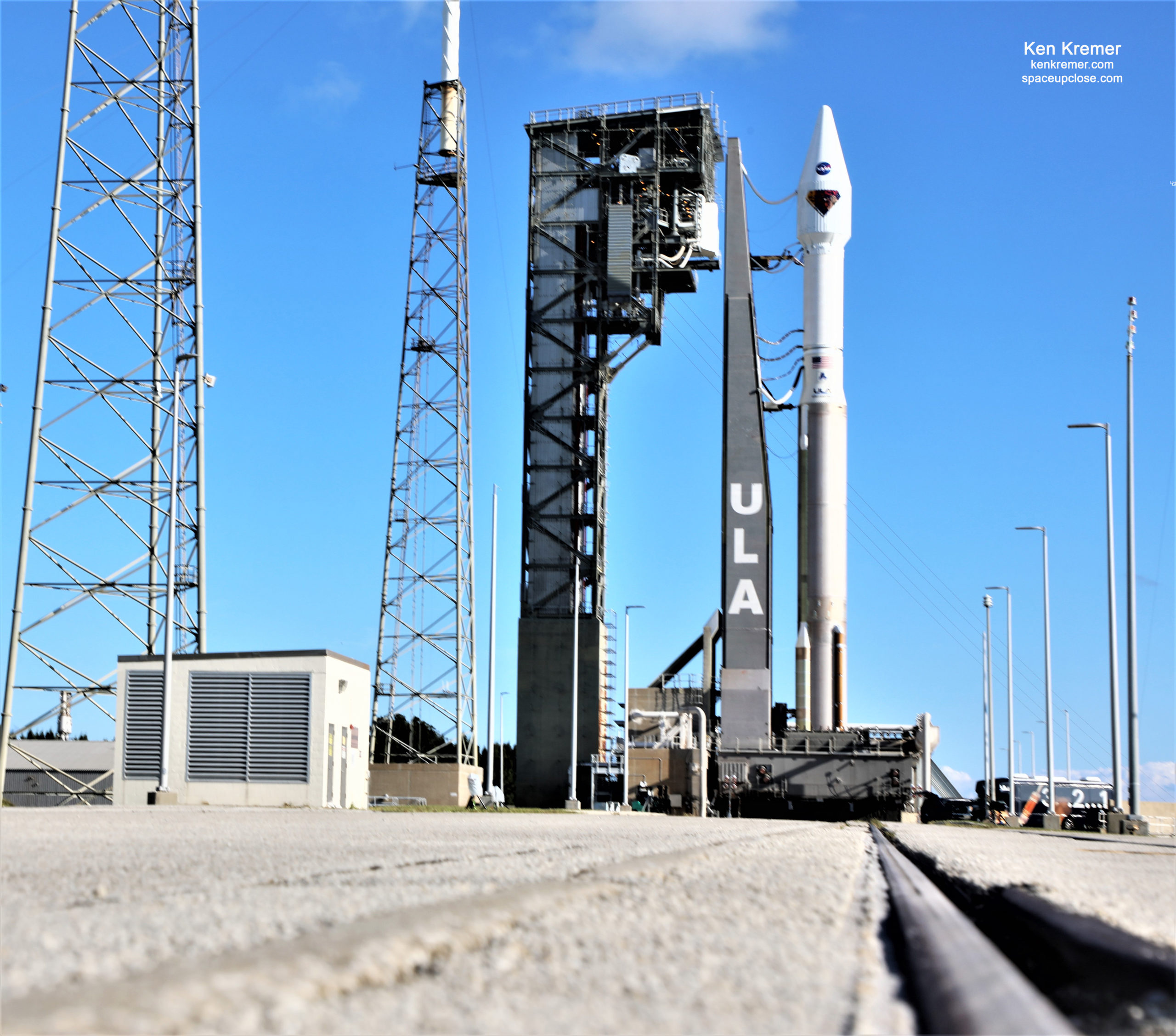
For SpaceUpClose.com & RocketSTEM
KENNEDY SPACE CENTER/CAPE CANAVERAL SPACE FORCE STATION, FL – At T minus less than 12 hours and counting NASA’s Lucy spacecraft probe is poised for liftoff on a revolutionary mission as the first science probe from Earth aiming to explore the pristine Trojan asteroids – fossilized remnants leftover from the birth of our Solar System some 4.5 Billion years ago and sharing Jupiter’s orbit.
Lucy is slated to launch in darkness early morning on Sat. Oct. 16 from Florida’s Spaceport – and the weather looks to be outstanding!
The nearly $1 Billion Lucy craft embarks on a record-breaking history making voyage lasting 12 years encountering 7 different unexplored Trojan asteroids as well as one main belt asteroid.
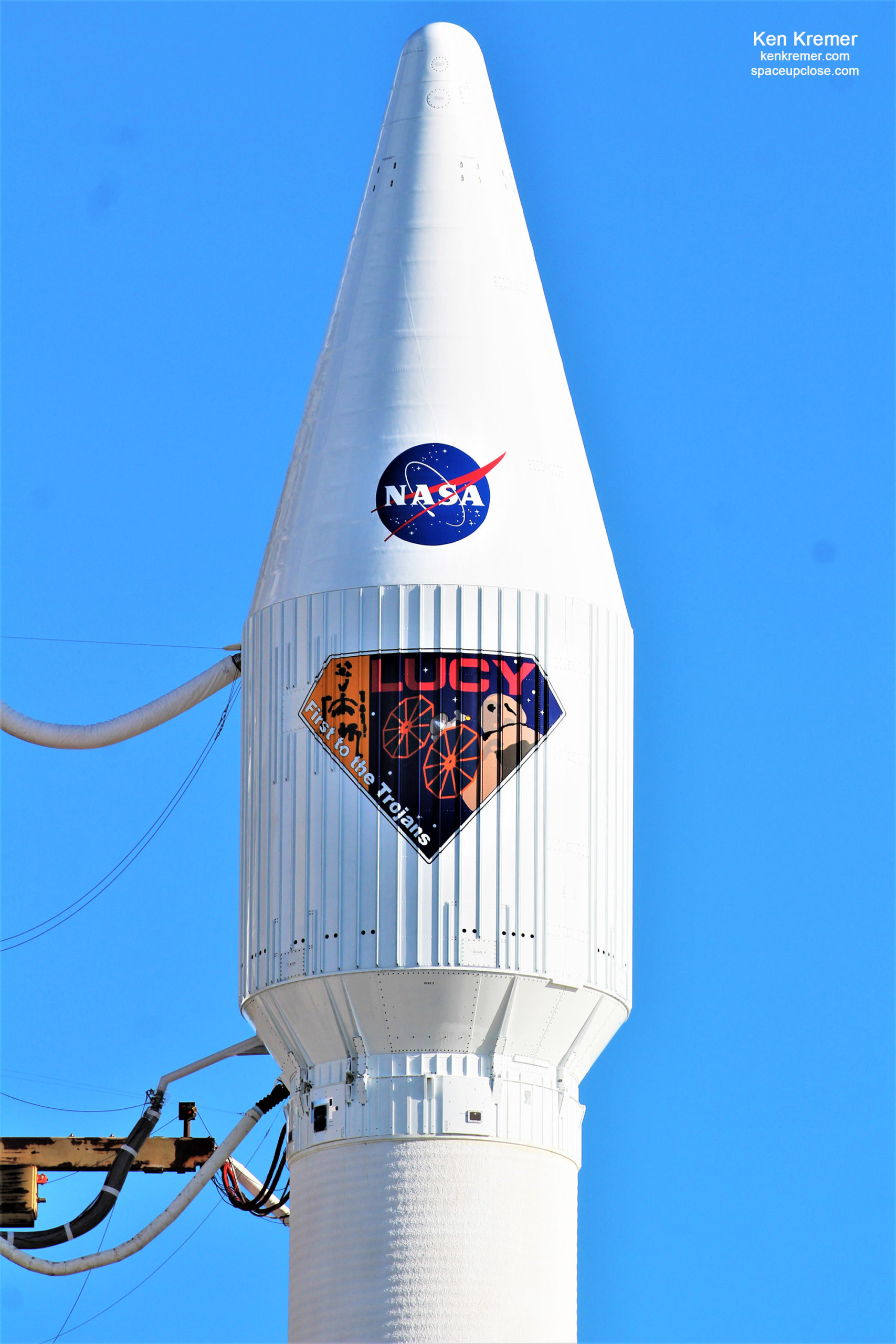
Enjoy our gallery of photos of NASA’s Lucy atop the United Launch Alliance (ULA) carrier rocket taken after rollout to pad 41 on Cape Canaveral Space Force Station for Space UpClose during our media remote camera setup this morning, Friday, Oct. 15.
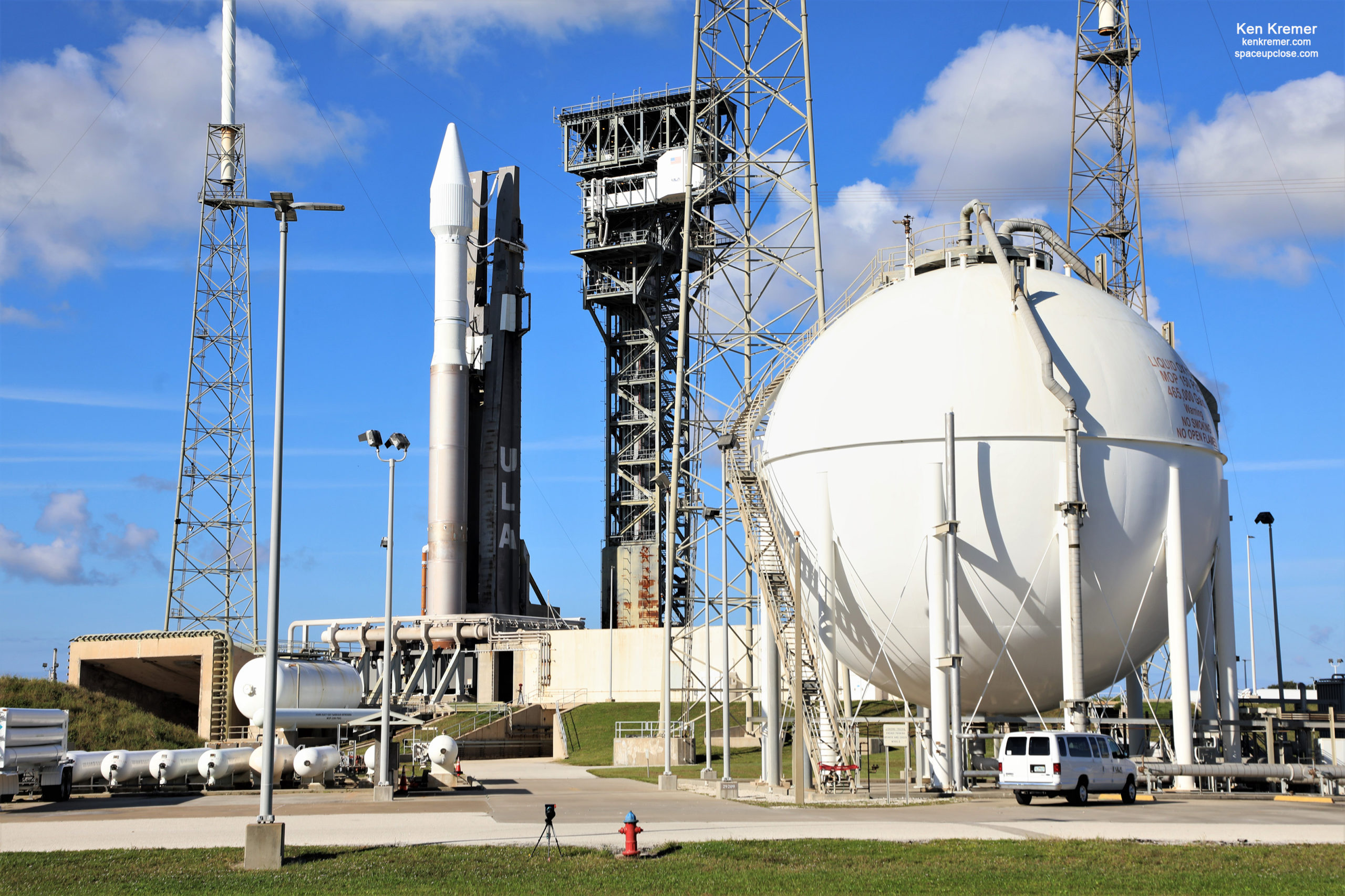
Following the Launch Readiness Review (LRR) conducted this week by the joint NASA/ULA/SWRI/Lockheed Martin teams for in depth analysis of the ULA Atlas V 401 rocket, mission operations, support functions, and the readiness of the Lucy team to support the launch, the teams gave a unanimous GO to proceed with launch preparations.
The successful LRR cleared the way for the integrated stack comprised of Lucy with the Atlas V rocket to be rolled out to pad 41 Thursday morning, Oct. 14.
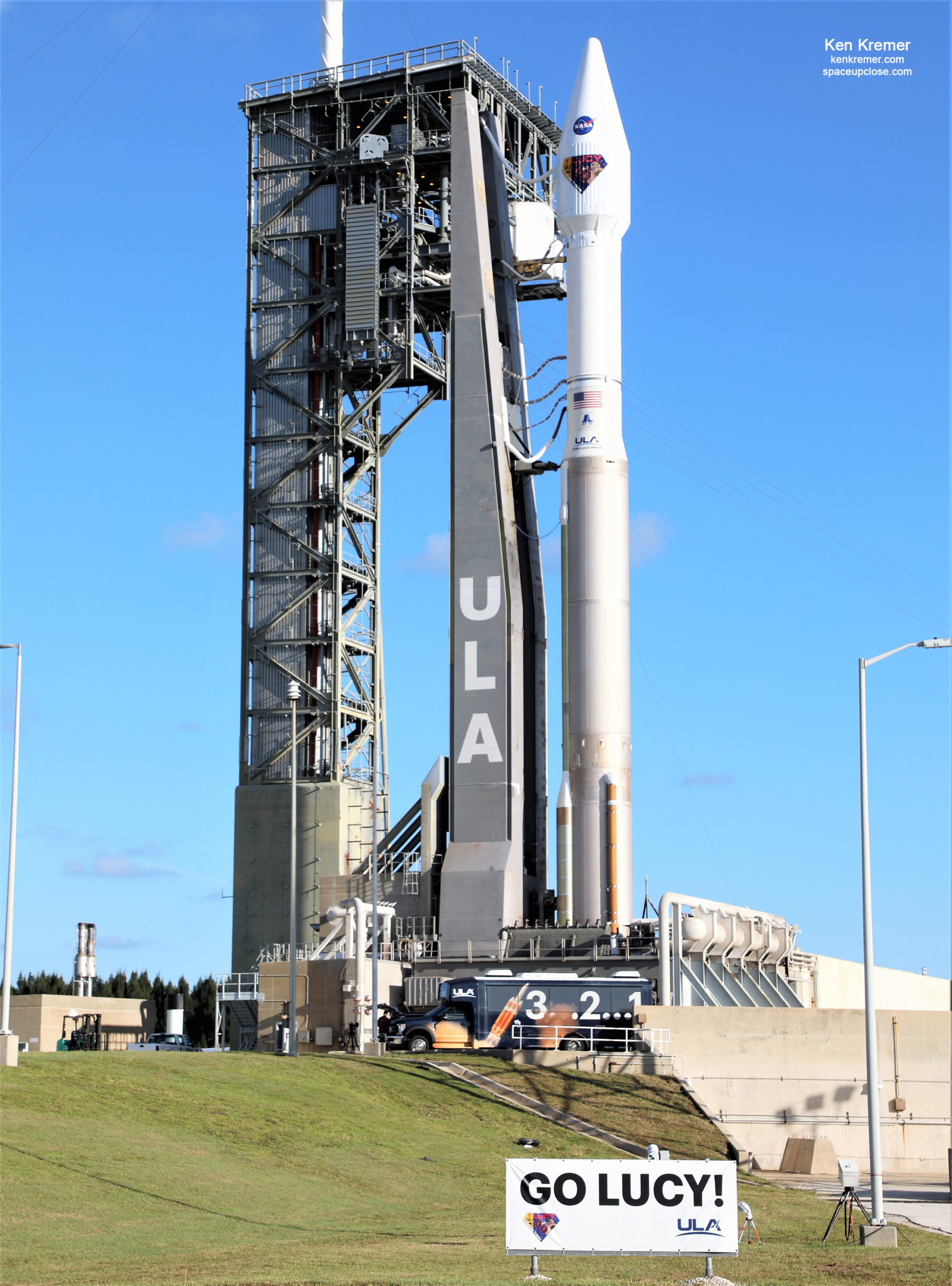
With the Atlas V due to be replaced in coming years by the Vulcan Centaur rocket under development by ULA, Lucy also marks the final planetary mission for the venerable and 100% successful rocket.
Launch is scheduled for 5:34 a.m. EDT on Saturday, Oct. 16, 2021, just before sunrise on a ULA Atlas V rocket from Space Launch Complex 41 at Cape Canaveral Space Force Station in Florida.
The launch opportunity runs 75 minutes until 6:49 a.m. on Oct. 16 and the overall launch window lasts just over three weeks.
NASA’s live launch countdown and launch broadcast will begin Oct. 16, at 5 a.m. on NASA Television and the agency’s website,
Also on YouTube, Twitter, Facebook, LinkedIn, Twitch, Daily Motion, Theta.TV and NASA’s App.
Also follow along on NASA’s Lucy blog.
Want to witness the launch of @NASA’s Lucy spacecraft? 🚀
Tune in tomorrow, Oct. 16 at 5am ET for live coverage as the #LucyMission launches to the ancient Trojan asteroids aboard this @ULALaunch Atlas V rocket: https://t.co/xb3hu5q83w pic.twitter.com/vjsohiqcU1
— NASA's Kennedy Space Center (@NASAKennedy) October 15, 2021

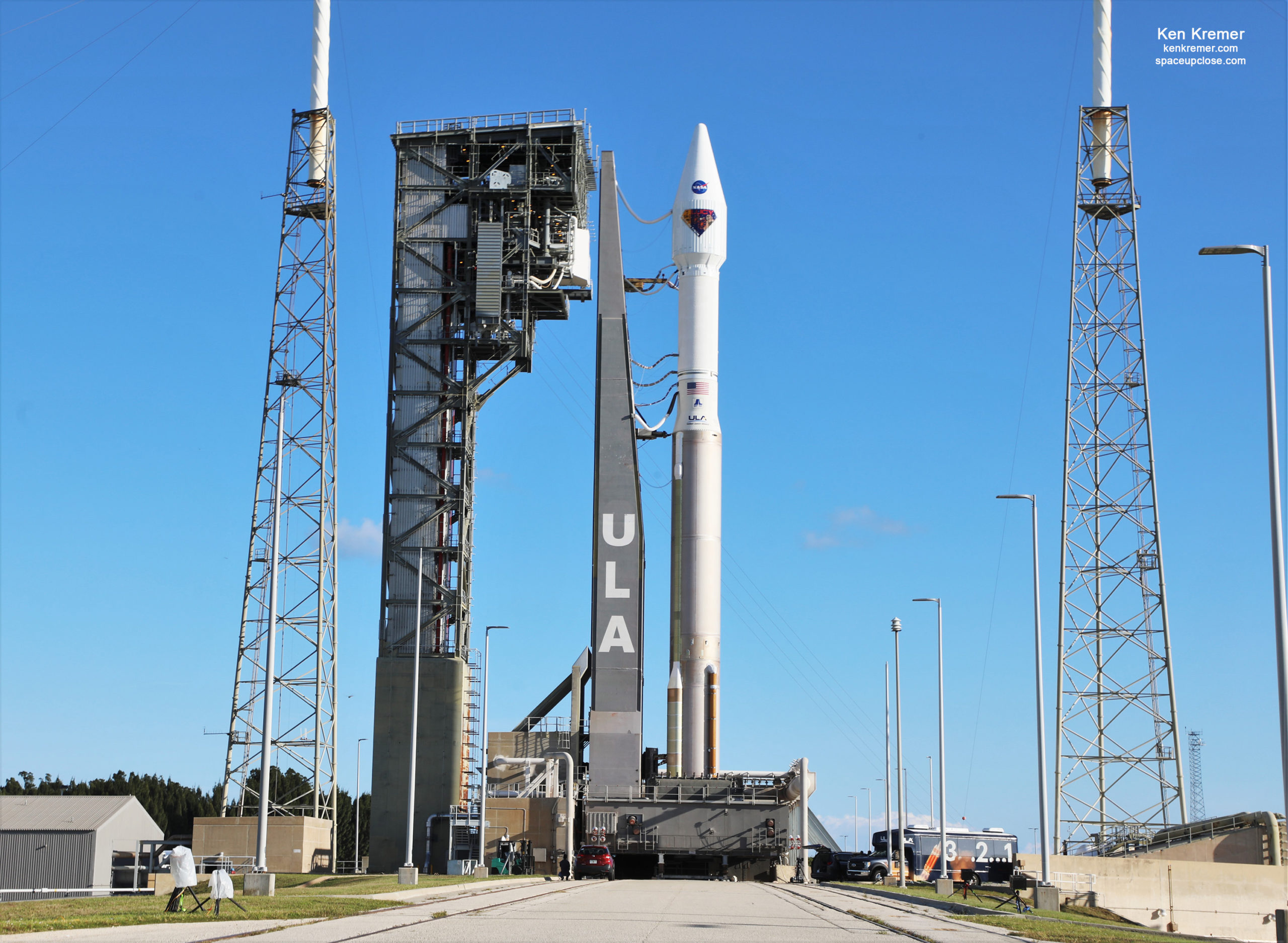
Weather outlook for launch of the Lucy spacecraft is currently excellent at 90 percent “GO” with only a 10 percent chance of violating a weather constraint, the cumulus cloud rule, according to Jessica Williams, launch weather officer with the 45th Weather Squadron, Space Launch Delta 45 at Cape Canaveral Space Force Station
A backup launch opportunity on Sunday, Oct. 17, drops to only 50% GO.
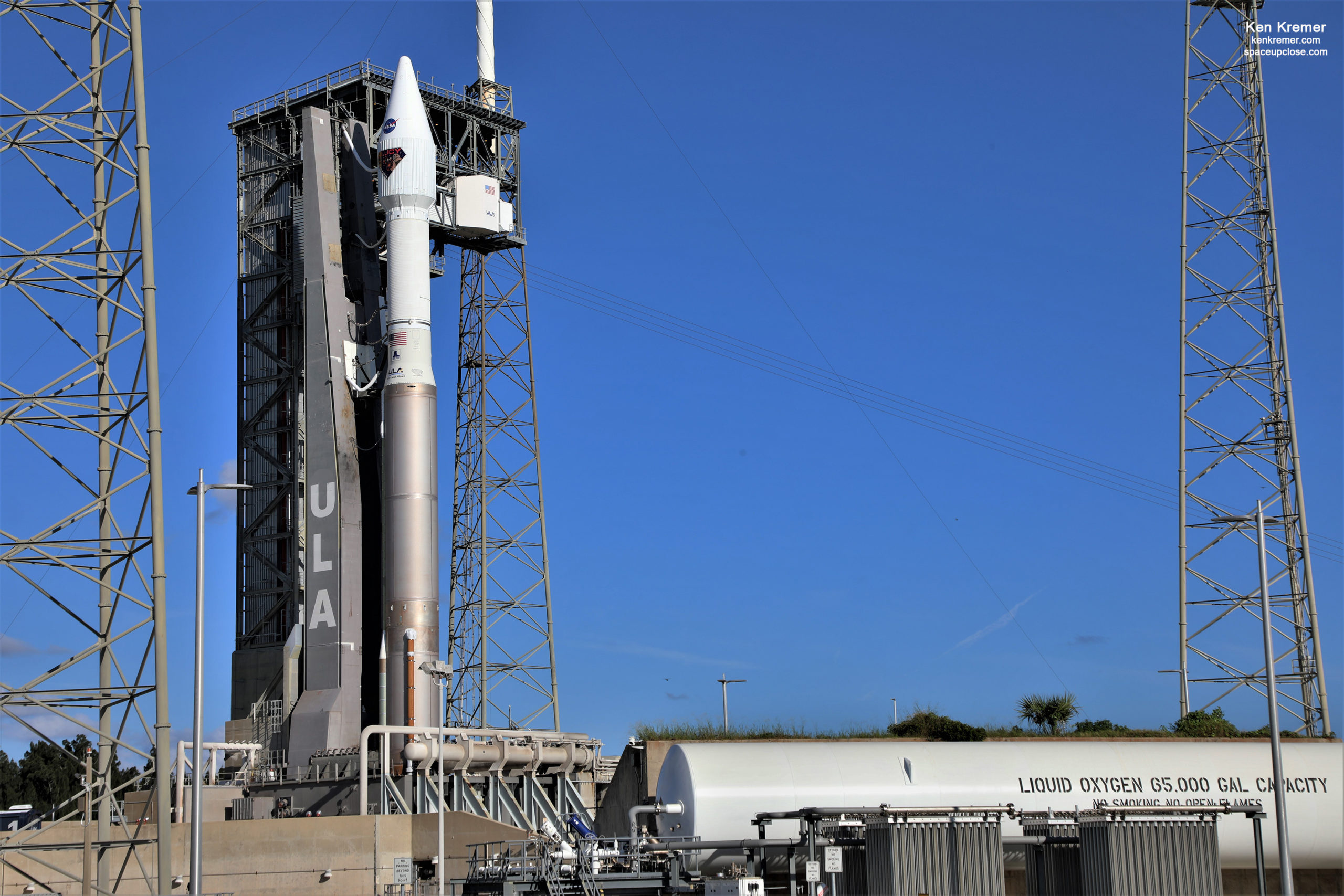
NASA’s Lucy is an ambitious probe unprecedented in scope utilizing a ‘once-in-a-lifetime planetary launch window’ that will explore seven pristine Trojan asteroids orbiting ahead of and behind Planet Jupiter at the L4 and L5 Lagrange points and one main belt asteroid during a mission spanning 12 years.
Lucy will be the first spacecraft from Earth to study Jupiter’s Trojan asteroids.
Like the mission’s namesake – the fossilized human ancestor, “Lucy,” whose skeleton provided unique insight into humanity’s evolution – Lucy will revolutionize our knowledge of planetary origins and the formation of the solar system some 4.5 Billion years ago.
“At the heart of Lucy is the science and how it’s going to talk to us about the Trojans,” said Dr. Thomas Zurbuchen, associate administrator, NASA’s Science Mission Directorate at the Oct. 13 media briefing
“I keep thinking about these millions of pieces out there that we haven’t observed and how it’s so important to go observe them because just like so many of these small worlds, these asteroids that tell us about a chapter of our own story, our own history, in this case, the history perhaps 4 billion years ago or so when the outer planets were forming in the solar system.”
“[NASA] LSP is excited about the launch of Lucy this Saturday,” said Omar Baez, Lucy launch director, NASA’s Launch Services Program (LSP), “Our team is ready, and we look forward to a beautiful launch.”
Read our full stories about the Lucy mission and goals and the cleanroom visit and rollout photo gallery story here.
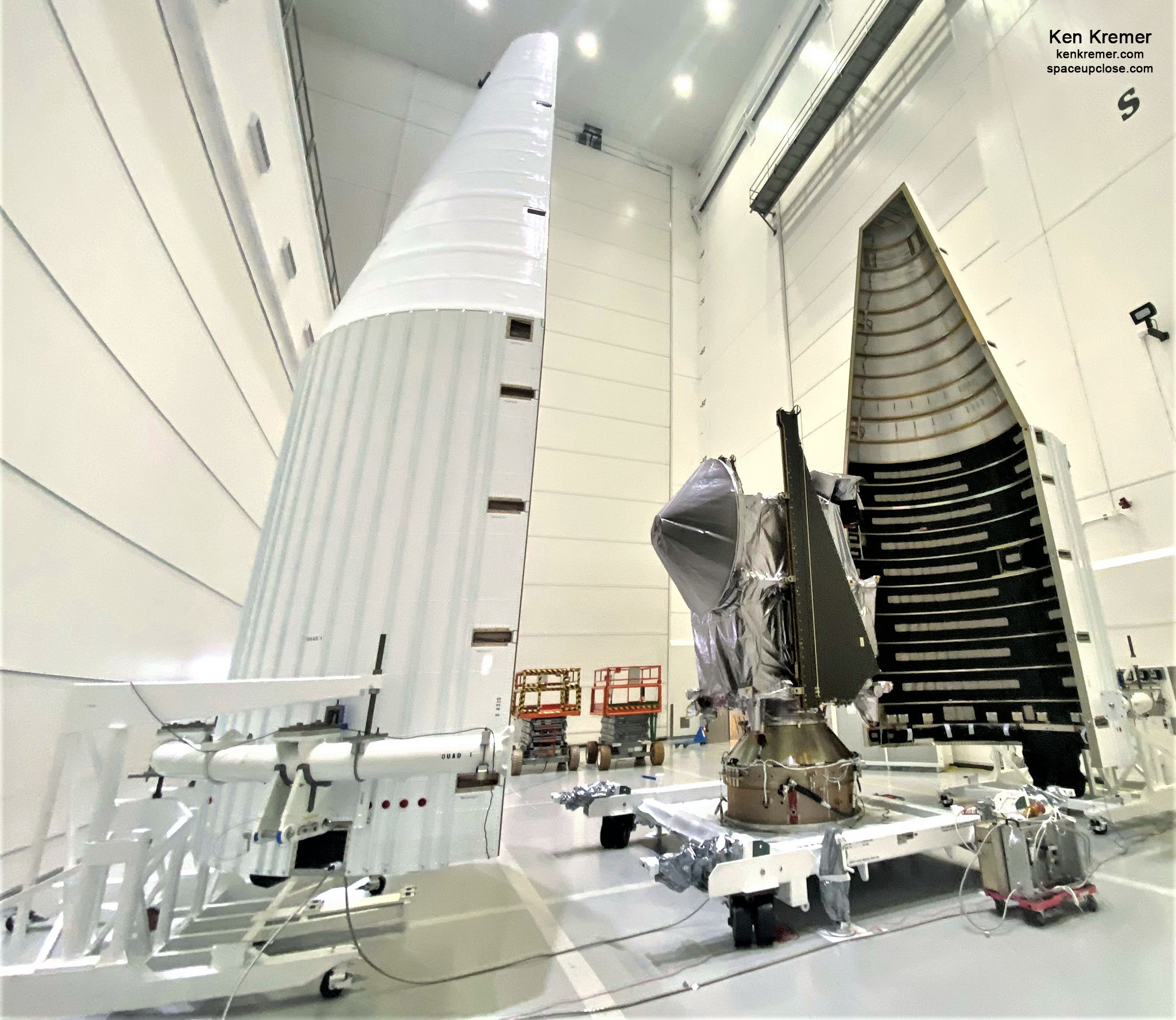
The Atlas V rocket with the Lucy spacecraft aboard stands 188 feet (57.3 meters) tall and will weigh 742,913 pounds (336,980 kg) at liftoff.
Lucy will launch on an Atlas V 401 configuration rocket, that includes a 14-ft (4-m) diameter large payload fairing (LPF) and stands 188 ft (57.3 m) tall.
The Atlas booster for this mission is powered by the RD AMROSS RD-180 engine with no thrust augmentation from first stage solid rocket boosters.
Aerojet Rocketdyne provided the RL10C-1 engine for the Centaur upper stage to which Lucy is attached until payload seperation.
ULA CEO Tory Bruno eloquently explains why they invented RAAN steering for #AtlasV rocket launching NASA’s #LucyMission-which increases launch window from 1sec to 4500sec or 75min! “& still intercept correct interplanetary trajectory” to explore record breaking 7 Trojan asteroids
#ToryTalk // RAAN steering is part of ULA's secret sauce to achieve the most accurate orbital insertions in the industry. @ToryBruno explains how #AtlasV will be able to launch #LucyMission any time within the launch window & still intercept the correct interplanetary trajectory. pic.twitter.com/4o1TAJG6eM
— ULA (@ulalaunch) October 15, 2021
The Lucy mission will be the 89th launch of the Atlas V rocket and marks the 100th launch from SLC-41 at Cape Canaveral Space Force Station. To date ULA has launched 145 times with 100 percent mission success.
Lucy will be the first space mission to study the Jupiter Trojan asteroids – fossilized remnants of our early solar system trapped in stable orbits
The Trojans are believed to be comprised of the initial material that formed the planets within the solar system.
No other space mission in history has been launched to as many different destinations in independent orbits around the Sun! says the Lucy team.
Lucy’s 5 Deep Space Maneuvers and 3 Earth Gravity Assists will keep the spacecraft on target!
Watch this NASA visualization:
#CountdowntoLaunch! 11 days until the start of the #LucyMission's epic voyage! In order for Lucy to explore 6 asteroid systems over 12 years, we will need to drive the spacecraft. Lucy's 5 Deep Space Maneuvers and 3 Earth Gravity Assists will keep the spacecraft on target! pic.twitter.com/wKGEGYUDaJ
— Lucy Mission (@LucyMission) October 5, 2021
Here is a detailed outline of the Lucy asteroid flyby tour:
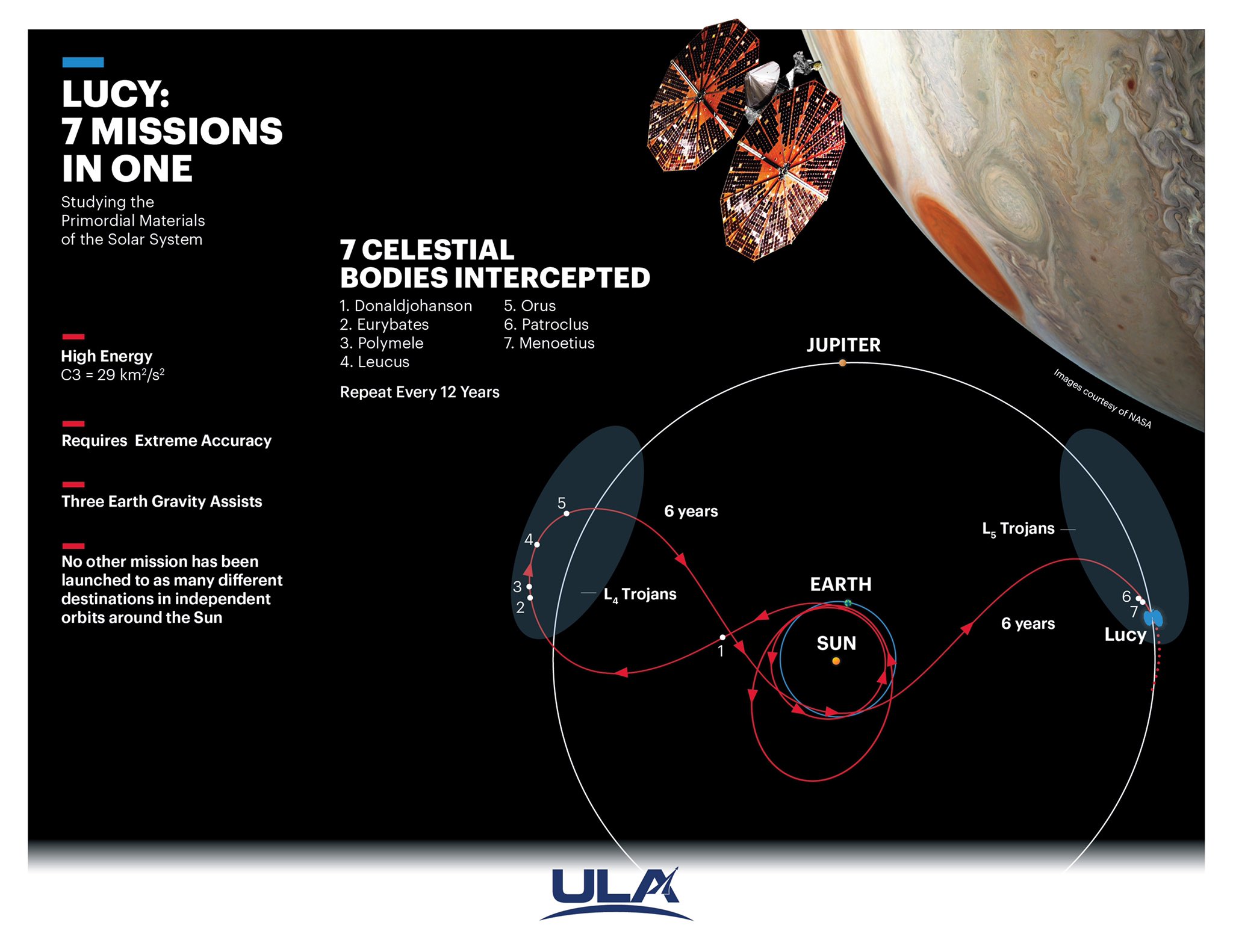
After launching on the Atlas V in Oct 2021, Lucy will carry out two Earth flyby maneuvers in Oct 2022 and Dec 2024 to set up the asteroid flyby tour.
Then it will fly by a main belt asteroid Donaldjohanson in April 2025 named after the discoverer of the Lucy fossil in Ethiopia
The Trojan asteroid flyby’s begin in the L4 swarm in August 2027 leading Jupiter with a total of 5 asteroid encounters, one of which is a binary, and continuing for 15 months into 2028 through November.
During the 4156 day mission Lucy will investigate seven Trojan asteroids, which lead and follow Jupiter in its orbit by roughly 60 degrees and one main belt asteroid that “hold vital clues to the history of the Solar System.”
The Trojans are clustered in two “swarms” of asteroids at the L4 and L5 Lagrange points centered 60 degrees ahead of and behind massive Jupiter in its path around the Sun as the largest planet on our Solar System
These asteroids are thought to be remnants of the initial material that formed the planets within the solar system.
Lucy is a Discovery class mission led by principal investigator Harold “Hal” Levison from the Southwest Research Institute in Boulder, Colorado.
“Lucy provides us with a unique opportunity,” says Levison.
“Because the Trojans are remnants of the stuff that formed the outer planets, they are literally the fossils of planet formation. Lucy, like the human fossil for which it is named, will revolutionize the understanding of our origins.”
“Jupiter’s swarms of Trojan asteroids may be remnants of the primordial material that formed the outer planets, and serve as time capsules from the birth of our solar system more than 4 billion years ago. Lucy will be the first space mission to study the Trojans.”
The mission takes its name from the fossilized human ancestor (named “Lucy” by her discoverers) whose skeleton provided unique insight into humanity’s evolution.
“Lucy will complete a 12-year journey to seven different asteroids.”
Lockheed Martin Space in Littleton, Colorado, is prime contractor for the Lucy mission and built the spacecraft.
You can watch my new prelaunch interview presentation about the Lucy mission on the Oct. 6 edition of the ‘Stay Curious’ space show from the American Space Museum, Titusville, Florida – including many of my cleanroom photos – see video below.
https://www.facebook.com/SpaceWalkOfFame/videos/686060975688731
My photos of Lucy in the clean room have been featured on WFTV ABC 9 Orlando in multiple broadcasts leading up to launch
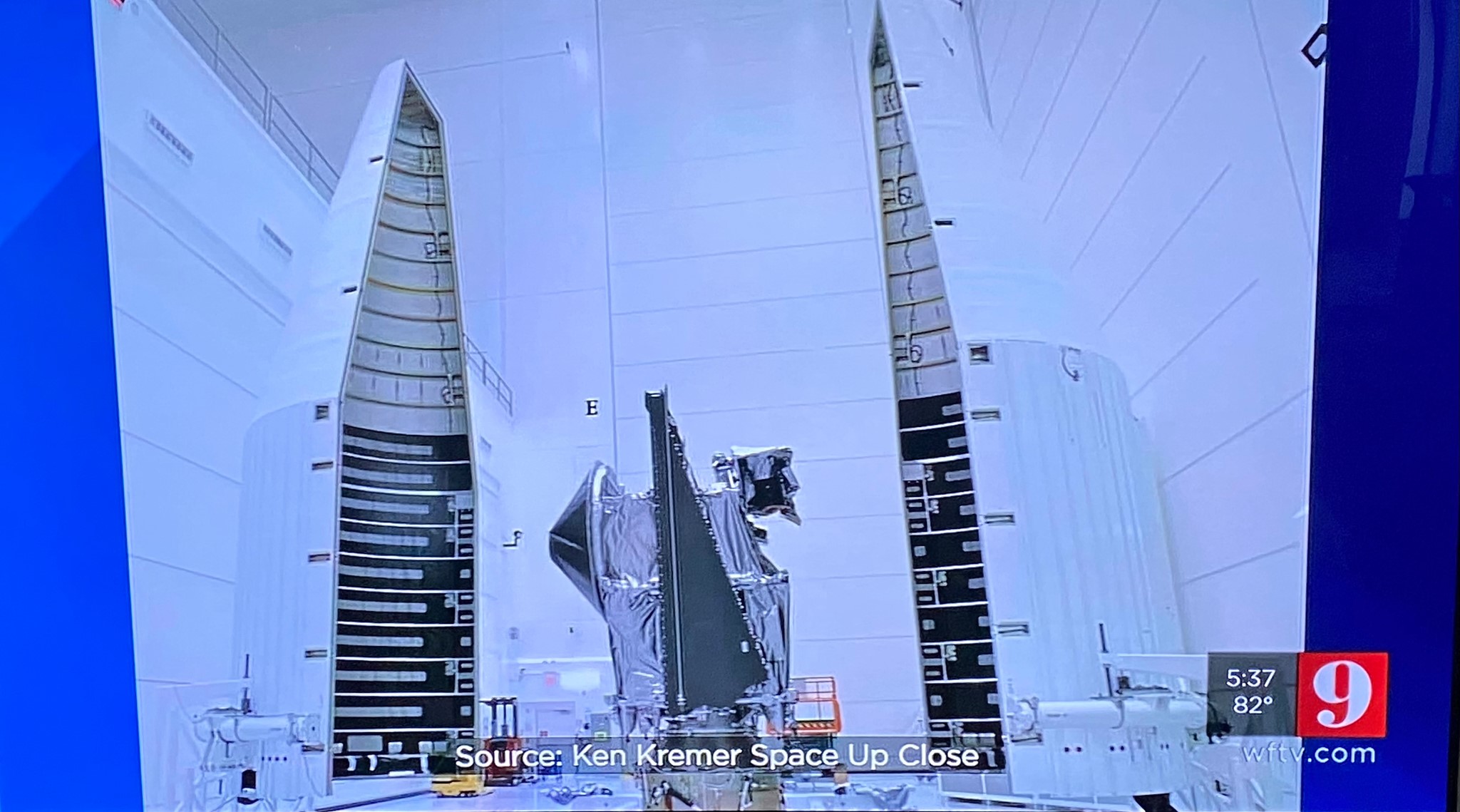
My rollout and photos have been featured on WKMG CBS 6 Orlando in multiple broadcast leading up to launch.
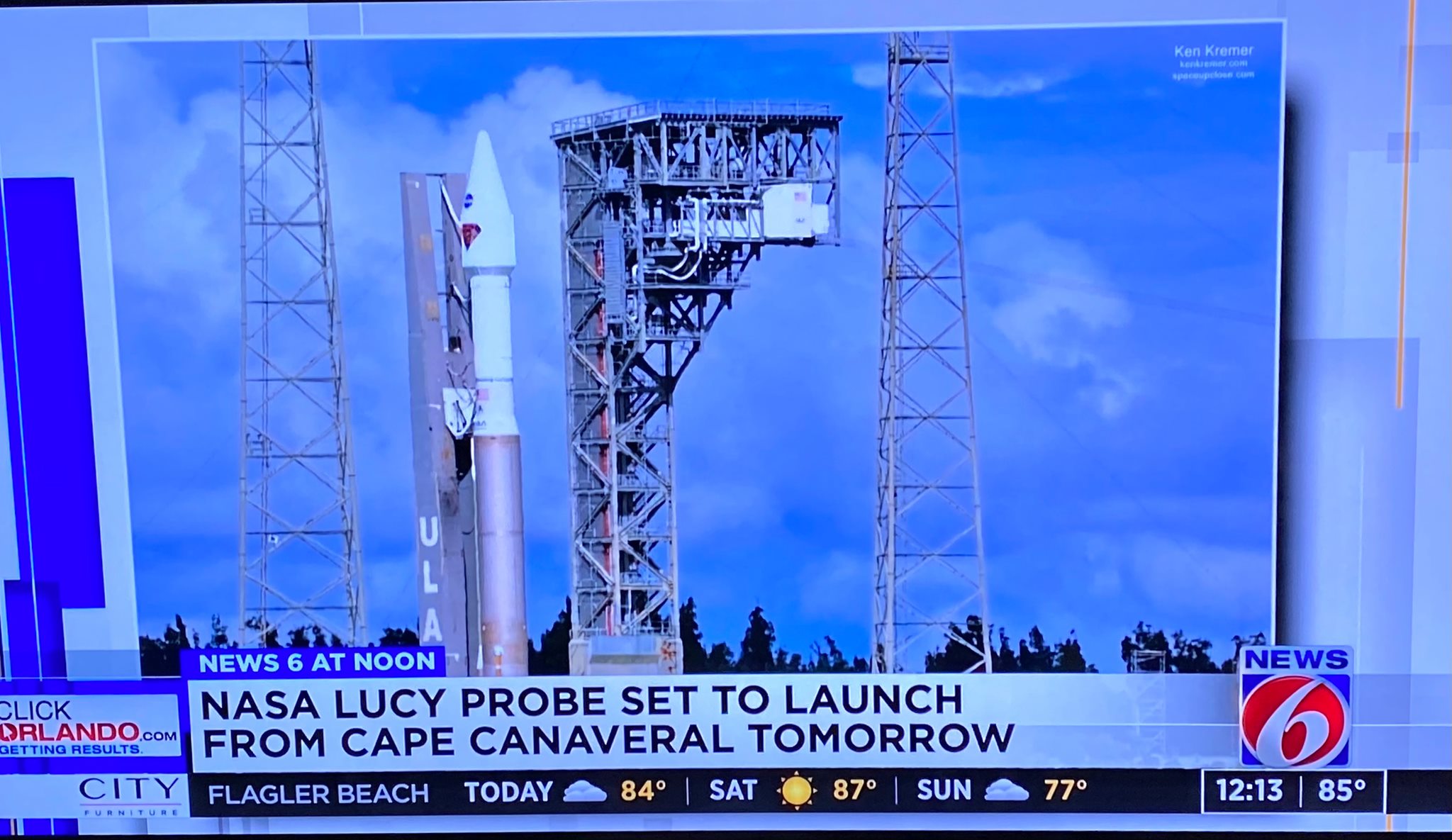
Ken is onsite at NASA’s Kennedy Space Center for reporting about the Lucy mission
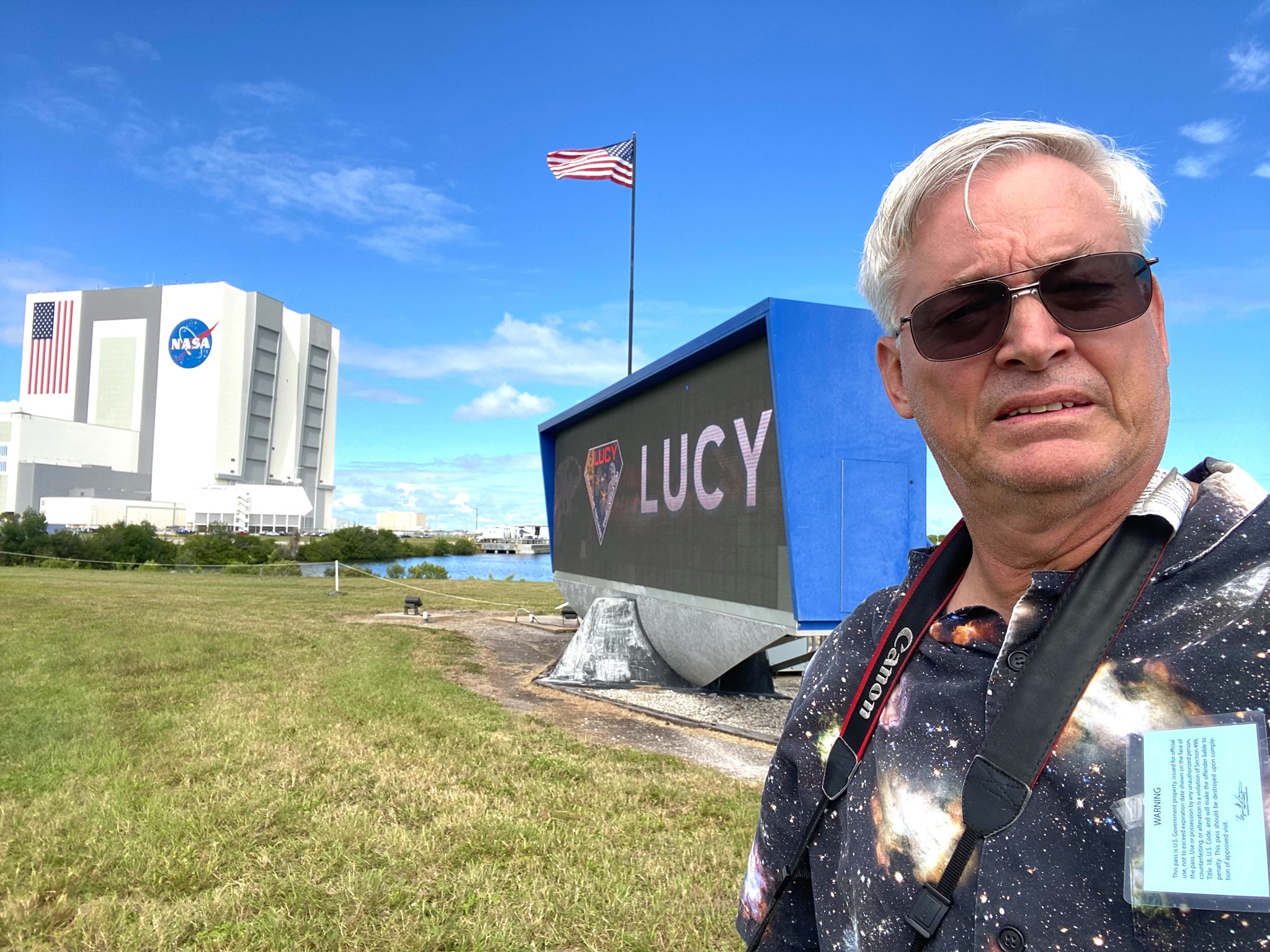
Watch Ken’s continuing reports about Lucy Asteroid mission, Blue Origin and Space Tourism, SpaceX Cargo and Crew Dragons, Artemis and NASA missions, SLS, Orion, SpaceX Starlink, Commercial Crew and Starliner and Crew Dragon and onsite for live reporting of upcoming and recent SpaceX and ULA launches including Crew 1 & 2 & 3, ISS, Solar Orbiter, Mars 2020 Perseverance and Curiosity rovers, NRO spysats and national security missions and more at the Kennedy Space Center and Cape Canaveral Space Force Station.
Stay tuned here for Ken’s continuing Earth and Planetary science and human spaceflight news: www.kenkremer.com –www.spaceupclose.com – twitter @ken_kremer – email: ken at kenkremer.com
Dr. Kremer is a research scientist and journalist based in the KSC area, active in outreach and interviewed regularly on TV and radio about space topics.
………….
Ken’s photos are for sale and he is available for lectures and outreach events
Please consider supporting Ken’s work by purchasing his photos and/or donating at Patreon:
https://www.patreon.com/kenkremer
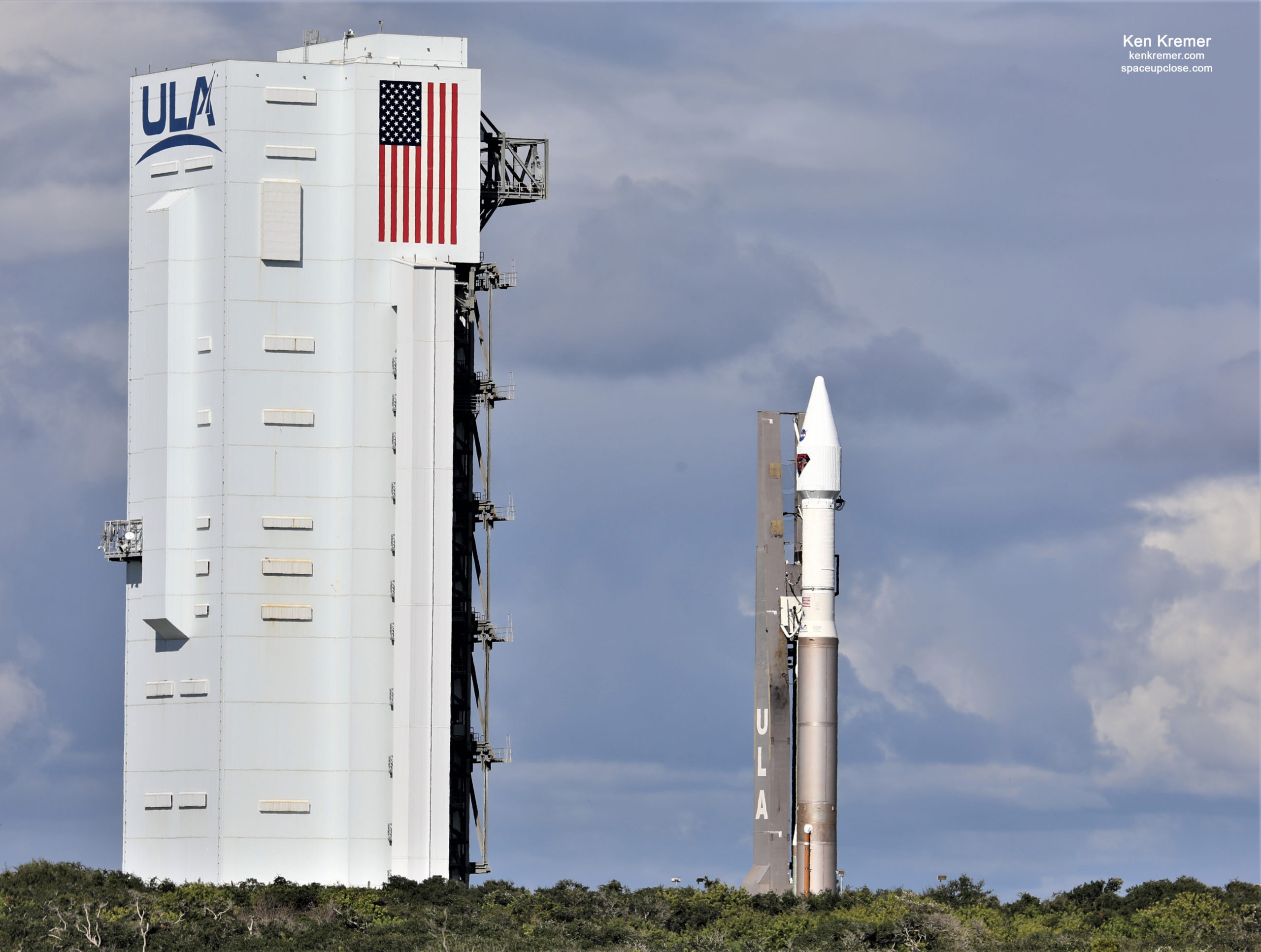
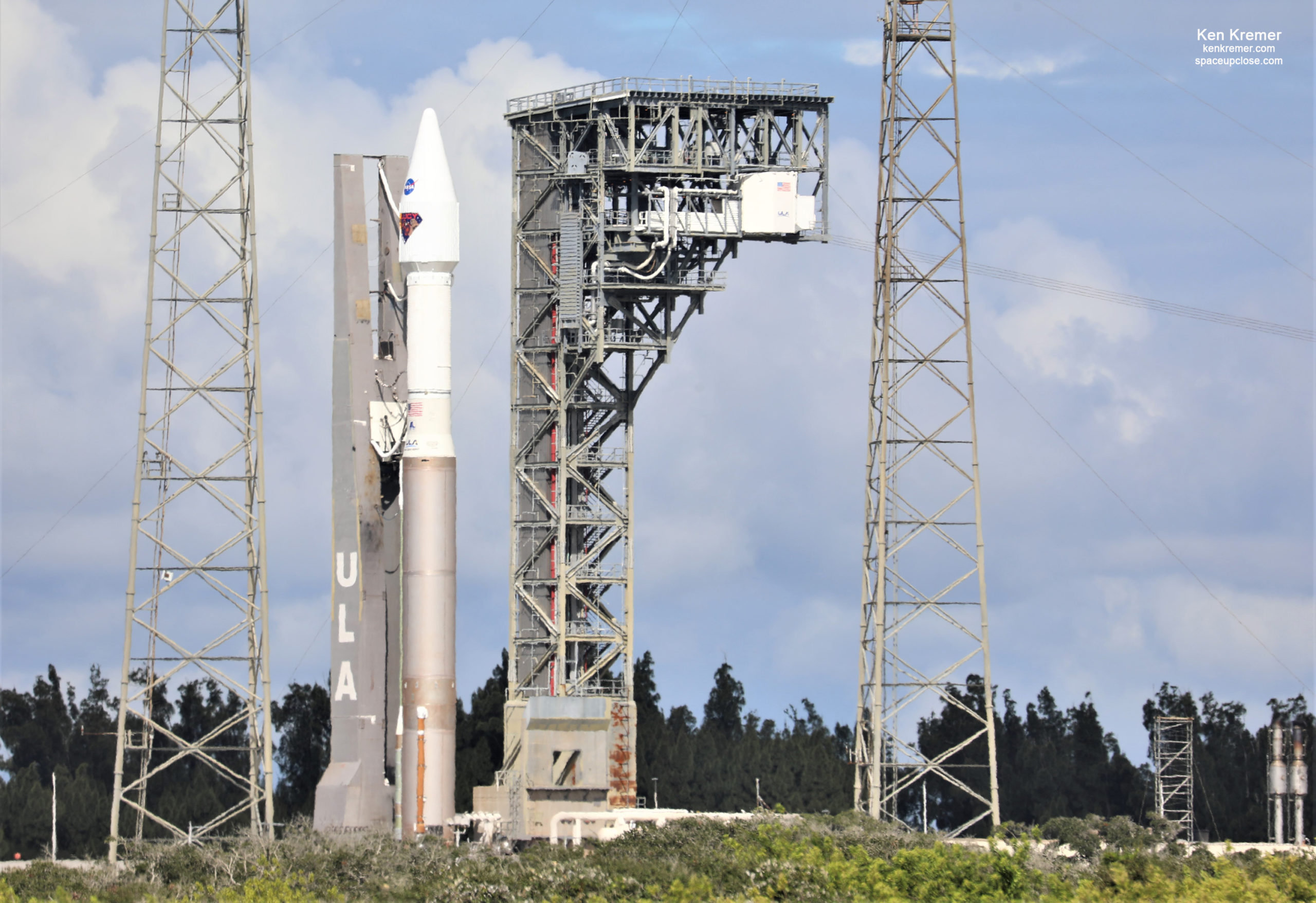
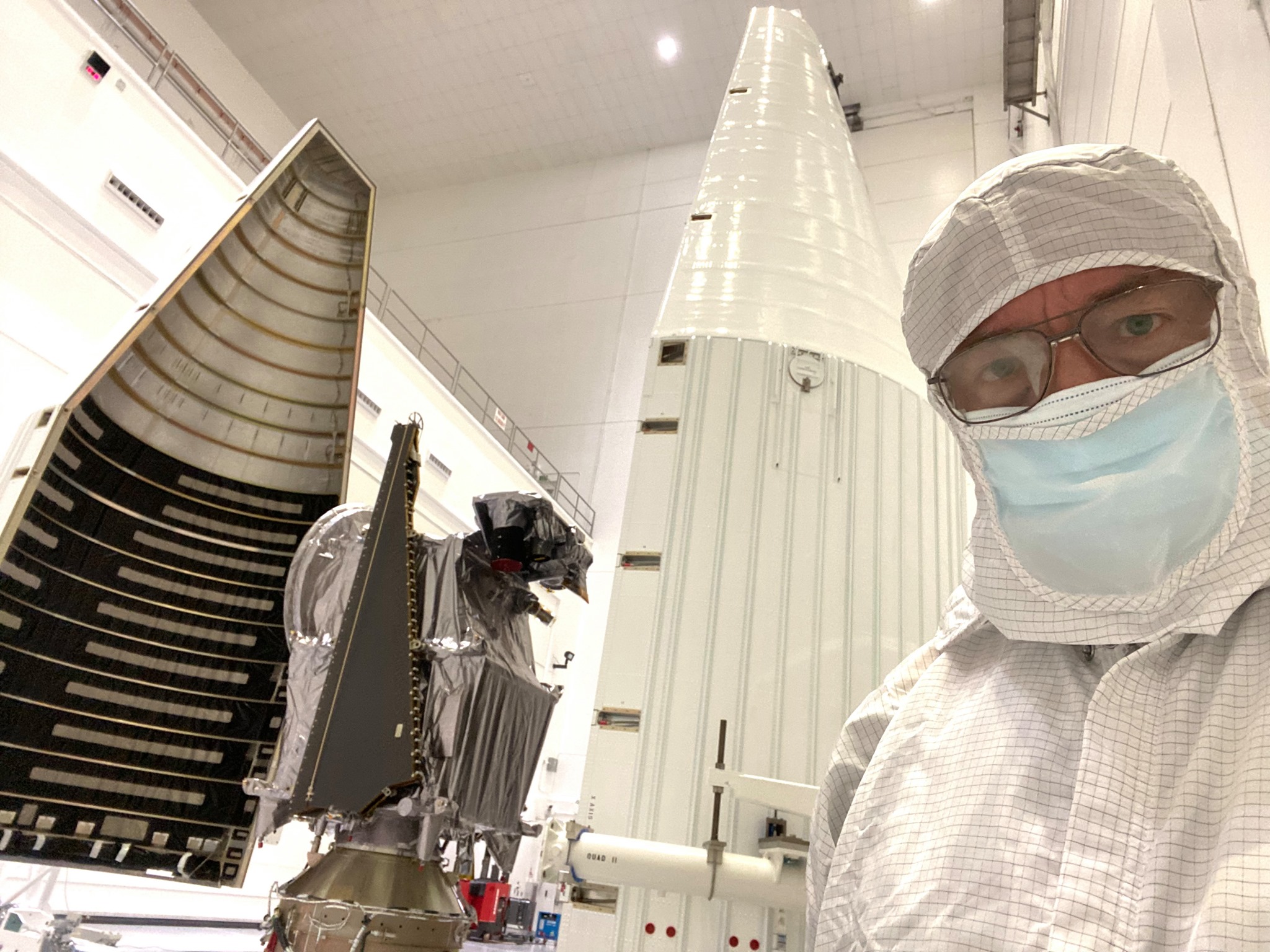
x



